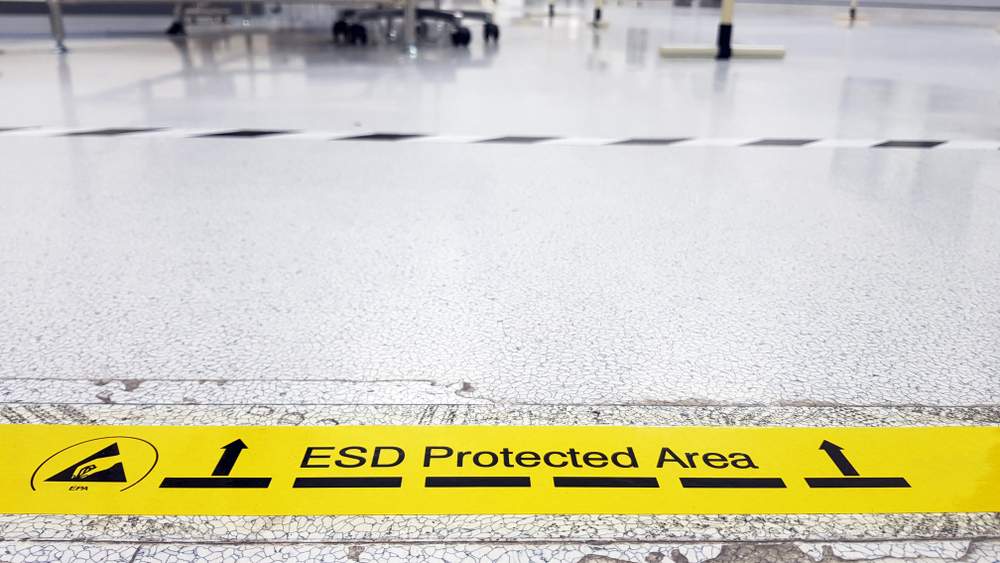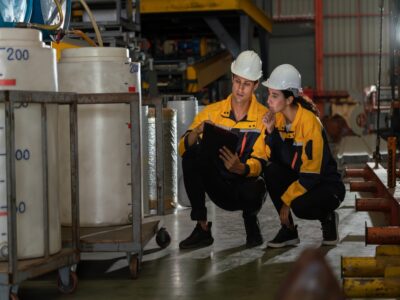Search
Static Electricity Safety: Making sense of Volume Resistivity, Surface Resistivity, and Charge Decay Time

Do your eyes glaze over at the sight of ‘specifications’ when trying to purchase ‘static dissipative’ or ‘conductive’ packaging, hoses/pipes, filter bags, and equipment? All those huge numbers with odd units of measurement. What is the difference between “volume” and “surface resistivity”? What is an “ohm.m” or an “ohm per square”? And how do we know what equipment is “static-safe” when we read the equipment specifications?
In this issue of Process Safety Dispatch, we address these and other questions relating to the selection of equipment (liners, hoses, drums, connectors….) designed to help control static electricity and which can be safely used in Class I and Class II flammable atmospheres. But before we do, let’s consider why we are interested in these parameters.
If we are assessing the possible hazards from static electricity, all we really need to know is if there can be any hazardous build-up of static electricity on our plant, people, equipment, and processed materials. If there is no static accumulation on anything then there is no risk of static discharge/spark to cause ignition, fire, or explosion. Simple? Unfortunately, whenever there is movement that involves contact and separation of any surfaces, charge WILL ALWAYS be generated. What is less certain is whether that charge will build-up or simply conduct away safely to ground/earth. Enter volume resistivity, surface resistivity and charge decay (relaxation) time!
Static Electricity: Back to Basics
Electrical resistance is the parameter that determines how easily electric current, or charge per second, will flow through or over the surface of a material. From our school days we can quickly recite the ‘Ohm’s Law’:
Voltage = Current x Resistance
or
V[volts] = I[amps] x R[ohms]
If we are concerned with electrostatic hazards then we see from ohms law that any electrostatic charge generated (a current) can lead to a build-up of voltage and that the higher the resistance or the higher the charging rate, the greater will be the voltage generated.
So far so good, but what exactly is this ‘resistance’ we are talking about here? If it’s a charged liquid or powder flowing through a pipe, we are interested in the resistance through the pipe wall and to earth. If it is a charged powder collecting in a lined drum, it is the resistance through the powder, through the liner, across the surface of the liner and through the drum to earth.
To help us understand what is going on here, consider the example of the plastic liner used inside a grounded fibre drum. If a charged powder enters the liner, then charge conduction towards ground will begin immediately, but the conduction path is not obvious. The charge can pass through the liner perhaps, or across the surface of the liner, or both. But it also has to pass through the bulking powder itself – this time both through the powder particles and also around the surfaces of every individual powder particle and through their contact points.
Perhaps you are starting to wonder how we can possibly measure or calculate the resistance through a pipe or through/across a powder, liner, and drum. Actually, calculation of these values is very difficult, but help is at hand. Fortunately, others have tackled this puzzle empirically and we have guidance that our electrostatic consultants and you can practically apply to real world situations. This guidance revolves around the measurable parameters of surface and volume resistivity, and sometimes charge decay (relaxation) time. If the values of these material properties are in certain ranges, and if there is a connection to ground, hazardous charge can be safely conducted away, thus preventing the build-up of the hazardous voltages and static discharges we want to avoid.
Defining the Terms
To get us all onto the same page let’s define the material properties we have mentioned above:
Surface Resistivity. The electric resistance of the surface of an insulator, in ohms per square, as measured between the opposite sides of a square on the surface, and whose value in ohms is independent of the size of the square or the thickness of any surface.
Volume Resistivity. The intrinsic property of a material that offers resistance to the flow of electric current through the material, expressed in ohm.meter (ohm.m).
Charge Decay (Relaxation) Time. The time for static electric charge to be reduced to a specified percentage of the charge’s original magnitude.
Relaxation Time Constant (t). The time, in seconds, for charge to decay by Ohm’s law to 1/e (36.7 percent) of its initial value. For a capacitor, the relaxation time constant is the product of resistance (ohms) and capacitance (farads).
We’ll also provide you with a few descriptive words you’ll find in the literature and define them with the help of NFPA 77 Recommended Practice on Static Electricity plus our own inferential work:
Conductive. Possessing the ability to allow the flow of an electric charge.
Static Dissipative (Antistatic). Capable of dissipating a static electric charge at an acceptable rate for the intended purpose.
Non-conductive (Insulating). NOT possessing the ability to allow the flow of an electric charge – or to severely limit the flow of charge
The Numbers that Matter
So, what are the magic values of “volume resistivity”, ‘surface resistivity” and “charge decay (relaxation) time” that make our powders, plant, and equipment materials safe? We will give you a table to get you started on answering this question, but we do so with a huge warning. There are numerous standards and guidelines around, including NFPA 77, that give specific resistance, resistivity, charge relaxation values for particular applications such as FIBCs, liners, resistance between hose couplings, gloves, footwear….. the list goes on. You must always ensure that if you are to purchase static-safe equipment then it must comply with its appropriate standard. Our process safety consultants know ALL the standards and limits and are always available to help you ensure you have materials/equipment that meet their appropriate standards. And our specialist electrostatic laboratories spend plenty of time measuring and checking these parameters, equipment and powders (and liquids) for our clients. But here is a table defining where in general, the terms conductive, dissipative, and non-conductive:
[pdf-embedder url=”https://stonehousesafety.com/media/Table-for-Article.pdf” title=”Table for Article”]
The table shows, for example, that a powder with a volume resistivity of less than 109 ohm.m, if in contact with ground, is not likely to accumulate much static electricity [it is static dissipative]. Charge on the powder is likely to be lost in a second or less. It also shows that a liner with a surface resistivity of less than 1011 ohm per square will adequately conduct away static charge from its contents, if grounded. It’s always worth remembering though that these parameters can be affected by local humidity in particular. That’s why the measurements we make on materials and equipment in our labs are always conducted under ambient as well as conditions of low relative humidity.
And finally, remember when we started this piece, we referred to ohms law. From this we see that much higher values of resistivity than those classed as static dissipative in the table can sometimes work well at dissipating charge; if the rate of charge generation is small, the voltage build up will also be small. It all comes down to understanding the standards and limits of their applicability – and importantly, understanding the physics of what’s going on,
So, What Do I Do Next?
If you have any questions about the electrostatic specification of process materials or equipment for your facility, please give us a call at 609-455-0001. We do not sell equipment and do not make specific manufacturer recommendations – so our advice is independent and without bias. If you would like more help with control of static electricity on your facility, our electrostatic and process safety consultants would also be able to help through our specialist and focussed electrostatic hazard analyses of process facilities. More about this service is described here.
__________________________________________________________________________________
# The values for resistivity in the table are from NFPA 77.
Charge Relaxation Time (t) is related to Volume Resistivity (rv). For many substances, the relaxation time can be expressed approximately in terms of the Volume Resistivity of the material and its electrical permittivity:
t = eoer rv equation (1)
Where
t Charge relaxation time constant (sec)
eo Electrical permittivity of a vacuum = 8.85 x 10-12 (F/m)
er Relative permittivity of material (relative dielectric constant with a range of 1 –
80) [dimensionless] for most plastics this number is in the range 1 to 5.
rv Volume resistivity of material (ohm.m)
In the table we have used a lowest value of er=1 to calculate charge relaxation time. It should be noted that the above relationship is only approximate and that rv and t may be voltage dependent (if the substance tested is non-ohmic, for example). If electrical volume (bulk) resistivity is required, it is therefore advisable to measure this directly rather than attempting to calculate the value from the above equation.

Get in touch
To learn more about our expertise and services in dust explosion prevention & mitigation, call us at +1 609 455 0001 or email us at [email protected] today.
We also offer tailored virtual and in-company process safety training programs on Dust Explosions, Static Electricity and HAC (Hazardous Area Classification) and more. Find further information here.









